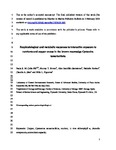Ecophysiological and metabolic responses to interactive exposure to nutrients and copper excess in the brown macroalga Cystoseira tamariscifolia
| dc.contributor.author | Celis-Pla, P | |
| dc.contributor.author | Brown, Murray | |
| dc.contributor.author | Santillan-Sarmiento, A | |
| dc.contributor.author | Figueroa, FL | |
| dc.date.accessioned | 2018-04-28T17:26:14Z | |
| dc.date.issued | 2018-03 | |
| dc.identifier.issn | 0025-326X | |
| dc.identifier.issn | 1879-3363 | |
| dc.identifier.uri | http://hdl.handle.net/10026.1/11374 | |
| dc.description.abstract |
Global scenarios evidence that contamination due to anthropogenic activities occur at different spatial-temporal scales, being important stressors: eutrophication, due to increased nutrient inputs; and metal pollution, mostly derived from industrial activities. In this study, we investigated ecophysiological and metabolic responses to copper and nutrient excess in the brown macroalga Cystoseira tamariscifolia. Whole plants were incubated in an indoor system under control conditions, two levels of nominal copper (0.5 and 2.0 μM), and two levels of nutrient supply for two weeks. Maximal quantum yield (Fv/Fm) and maximal electron transport rate (ETRmax) increased under copper exposure. Photosynthetic pigments and phenolic compounds (PC) increased under the highest copper levels. The intra-cellular copper content increased under high copper exposure in both nutrient conditions. C. tamariscifolia from the Atlantic displayed efficient metal exclusion mechanisms, since most of the total copper accumulated by the cell was bound to the cell wall. | |
| dc.format.extent | 214-222 | |
| dc.format.medium | Print-Electronic | |
| dc.language | en | |
| dc.language.iso | en | |
| dc.publisher | Elsevier | |
| dc.subject | Copper | |
| dc.subject | Cystoseira tamariscifolia | |
| dc.subject | Nutrient | |
| dc.subject | In vivo chlorophyll a | |
| dc.subject | Phenolic compounds | |
| dc.subject | Antioxidant capacity | |
| dc.title | Ecophysiological and metabolic responses to interactive exposure to nutrients and copper excess in the brown macroalga Cystoseira tamariscifolia | |
| dc.type | journal-article | |
| dc.type | Journal Article | |
| plymouth.author-url | https://www.webofscience.com/api/gateway?GWVersion=2&SrcApp=PARTNER_APP&SrcAuth=LinksAMR&KeyUT=WOS:000430645600025&DestLinkType=FullRecord&DestApp=ALL_WOS&UsrCustomerID=11bb513d99f797142bcfeffcc58ea008 | |
| plymouth.volume | 128 | |
| plymouth.publication-status | Published | |
| plymouth.journal | Marine Pollution Bulletin | |
| dc.identifier.doi | 10.1016/j.marpolbul.2018.01.005 | |
| plymouth.organisational-group | /Plymouth | |
| plymouth.organisational-group | /Plymouth/Faculty of Science and Engineering | |
| plymouth.organisational-group | /Plymouth/REF 2021 Researchers by UoA | |
| plymouth.organisational-group | /Plymouth/REF 2021 Researchers by UoA/UoA06 Agriculture, Veterinary and Food Science | |
| plymouth.organisational-group | /Plymouth/Research Groups | |
| plymouth.organisational-group | /Plymouth/Research Groups/Marine Institute | |
| dc.publisher.place | England | |
| dcterms.dateAccepted | 2018-01-03 | |
| dc.rights.embargodate | 2019-2-6 | |
| dc.identifier.eissn | 1879-3363 | |
| dc.rights.embargoperiod | Not known | |
| rioxxterms.versionofrecord | 10.1016/j.marpolbul.2018.01.005 | |
| rioxxterms.licenseref.uri | http://www.rioxx.net/licenses/all-rights-reserved | |
| rioxxterms.licenseref.startdate | 2018-03 | |
| rioxxterms.type | Journal Article/Review |


